| Home > Policy > White Paper, Notice, Announcement > White Paper > JAPANESE GOVERMENT POLICIES IN EDUCATION, SCIENCE, SPORTS AND CULTURE 1995 > Remaking Universities Chapter 2 Section 2 1 | ||
In addition to their role in the pursuit of scientific research, especially basic research, graduate schools contribute to the training of researchers and the development of human resources with advanced specialized skills. In fiscal 1995 there were graduate schools in all 98 of Japan's national universities, in 31 of its 52 local public universities, and in 256 of its 415 private universities. The 385 universities that have graduate schools represent approximately 70% of the 565 national, local public, and private universities in Japan ( Figure 2.10 ).
As of May 1995 there were 153,423 students enrolled in graduate schools: 97,704 in national universities, 6,555 in local public universities, and 49,164 in private universities. National universities thus account for two-thirds of total graduate school enrollment in Japan ( Figure 2.11 ).
Between 1975 and 1985 the number of graduate students increased by a factor of approximately 1.4, from 48,464 to 69,688. The number has more than doubled over the past decade and is likely to rise still further in the future ( Figure 2.12 ).
International comparison of the size of graduate schools as indicated by number of students enrolled, however, shows that Japan's ratio of graduate to undergraduate students is only 5.5%, compared with 15.4% in the United States, 37.2% in the United Kingdom, and 18.3% in France. Japan has 1.0 graduate student per 1,000 population, against 7.6 graduate students per 1,000 population in the United States, 3.3 in the United Kingdom, and 3.3 in France. By both measures, Japan lags behind other developed countries ( Figure 2.13 ).
Expectations of graduate schools have risen in step with various changes in recent years, including the advance of scientific research, rapid technological innovation, the increasing sophistication and complexity of social and economic systems, internationalization, and the shift to an information-oriented society. The achievement of significant qualitative and quantitative improvements in Japan's graduate schools has become the highest priority from the viewpoint of responding to these expectations and discovering new directions in scientific research.
For this reason, efforts are now being made to provide greater flexibility in the graduate school system, including course objectives, organizational structures, and educational methods and formats. The purpose of these changes is to enable individual graduate schools, in accordance with their own aims, to achieve further advancement and revitalization across a diverse range of educational and research activities. In addition, new departments and other organizations are being established to ensure that graduate schools are capable of meeting today's needs, especially in leading-edge and interdisciplinary fields.
Technological innovation and changes in the industrial structure have also generated a growing demand for human resources in occupations that require rich creativity and specialized knowledge and skills. The abilities required for such occupations are likely to become increasingly sophisticated and specialized, and graduate schools are expected to play a major role as centers for the development of the necessary human resources. Graduate schools need to work actively to train professionals with sophisticated specialized skills. They also need to enhance their refresher education * to enable people to enhance their knowledge or acquire knowledge in new fields during their working lives.
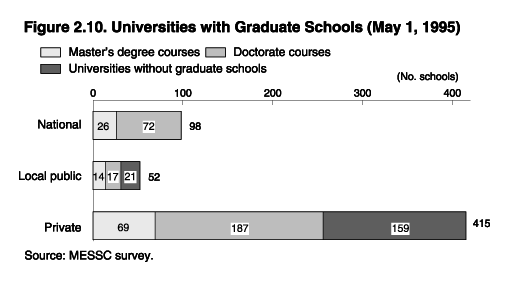
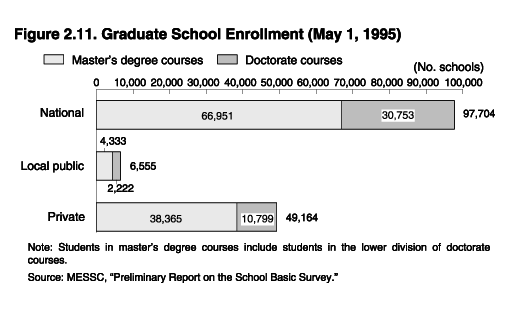
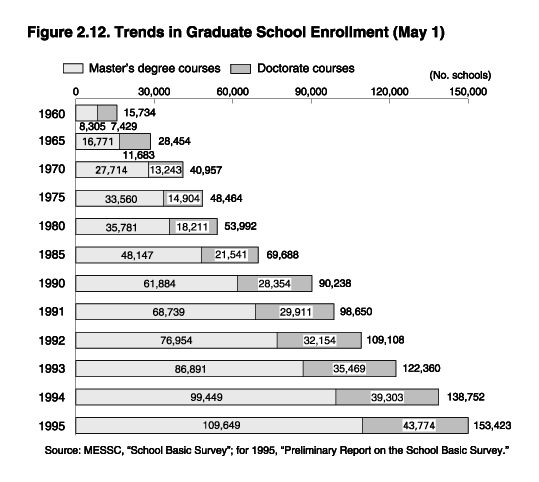
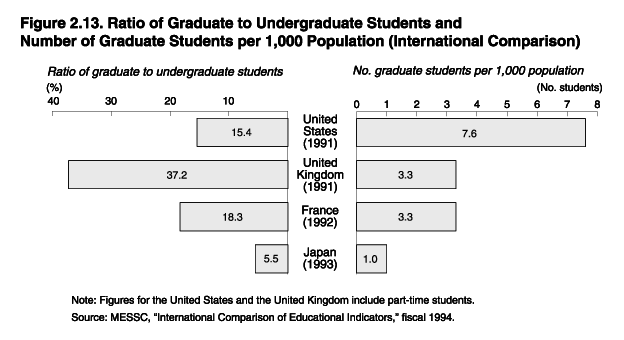
* Refresher education:
This is education provided by universities, graduate schools, and other institutions of higher education to enable workers to update their professional knowledge and skills or acquire new knowledge and skills.Some aspects of refresher education fall within the scope of recurrent education, but refresher education is more narrowly targeted. It is designed primarily for professionals and consists mainly of professional knowledge and technology. In addition, as mentioned, it is provided by institutions of higher education.
A number of changes have been made with the aim of bringing greater flexibility to the graduate school system. First, the aims of doctorate courses have been expanded to include not only the traditional goal of training researchers to work in universities and other institutions but also the training of professionals with advanced specialized skills that enable them to contribute to various sectors of society. Second, it has become possible to establish evening graduate courses to meet the needs of workers. Third, graduate schools are now able to reduce the required duration of study for students of exceptional ability. Fourth, students in master's degree courses are now able to receive research guidance in other universities and institutions for up to one year when this is deemed to be of educational or research benefit. Fifth, to provide a way for students who show exceptional aptitude for research to begin graduate studies earlier than usual, the system has been altered to allow such students to proceed directly to master 's degree course studies after completing the third undergraduate year. Sixth, students who have completed their undergraduate programs and have been involved in research at universities or research institutions for at least two years are now deemed qualified to enter the upper division of doctorate courses even if they have not completed master's degree courses. Seventh, in master's degree courses designed primarily to train professionals with advanced specialized skills the requirements concerning master 's degree theses have been changed to enable the thesis requirement to be waived at the discretion of the graduate school when this is deemed appropriate from the viewpoint of educational methods. Eighth, people with outstanding knowledge and experience in specialized fields and with advanced abilities in education and research can now be considered qualified to be graduate school teachers. The aim of this change is to attract human resources from nonacademic sectors of society so that people with exceptional knowledge and experience in specialized fields can contribute to graduate education and research.
Analysis of progress toward the introduction of greater flexibility with regard to entrance qualifications and duration of study shows that in fiscal 1992, 91 doctorate course students and 19 master's degree course students graduated before completing the required number of graduate years (master's degree courses require two years, doctorate courses five years). In fiscal 1994, 161 students entered graduate schools after completing their third year of undergraduate studies, while 174 entered the upper division of doctorate courses without completing master 's degree courses, after completing undergraduate courses and at least two years of research.
In fiscal 1991 the Degree Regulations were revised to reflect the aims of graduate schools by facilitating the granting of degrees and enabling graduate schools to respond more appropriately to the advance of scientific research. These changes have resulted in the abolition of the old system stipulated in the Degree Regulations, whereby degrees were conferred in individual fields of specialization, such as "doctor of literature" or "master of science." All master's degrees have now been integrated into "master's degree" and all doctorates into "doctorate"; the field of specialization can be attached to the degree at the discretion of the individual graduate school. Approximately 33,000 master 's degrees and about 12,000 doctorates were awarded in fiscal 1992.
There are many types of graduate schools. In addition to the traditional format of graduate departments and majors based on the educational and research organizations of undergraduate faculties, there are independent graduate departments and majors that encompass multiple faculties or disciplines, independent graduate schools that are not linked to undergraduate faculties, allied graduate schools and other types of research programs established by multiple universities, and linked graduate schools that work with research institutions and other nonuniversity establishments ( Figure 2.14 ).
In fiscal 1995 there were 65 independent graduate departments and 218 independent majors, including the Graduate School of Environmental Earth Science at Hokkaido University and the Graduate School of International Cooperation Studies at Kyorin University. New graduate departments and majors established in fiscal 1995 include the Graduate School of Polymathematics at Nagoya University, the Graduate School of Bio-Applications and Systems Engineering (BASE) at the Tokyo University of Agriculture and Technology, the course in Environmental Bioremediation (Graduate School of Agriculture) at Tohoku University, the Division of Educational Development and Cultural and Regional Studies (Graduate School for International Development and Cooperation) at Hiroshima University, the Graduate School of Policy and Management at Doshisha University, the Course in Development of Environmental Health Sciences (Graduate School of Nutritional and Environmental Sciences) at the University of Shizuoka, and the Course in Medical Science (Graduate School of Medicine) at Tokai University.
There are also universities that consist only of graduate schools. Their purpose is to provide a more appropriate response to trends in scientific research and to focus on advanced and interdisciplinary studies in leading-edge fields. Institutions of this type include the Graduate University for Advanced Studies; the Japan Advanced Institute of Science and Technology, Hokuriku; the Nara Institute of Science and Technology; and the International University of Japan.
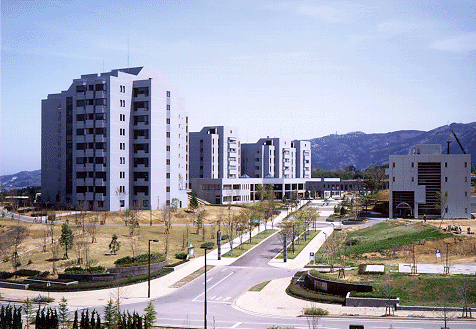
The Graduate University for Advanced Studies offers only the upper division of doctorate courses based on 11 interuniversity research institutes, including the National Laboratory for High Energy Physics and the Okazaki National Research Institutes. The university was established in fiscal 1988 to train researchers and other personnel capable of conducting pioneering scientific research. The Japan Advanced Institute of Science and Technology, Hokuriku, was founded in fiscal 1990 to train researchers and high-level technicians in advanced fields of information science and materials science. It forms the nucleus of Ishikawa Science Park, which is being developed as a center for advanced research and development. The Nara Institute of Science and Technology was established in fiscal 1991 as a core facility of Kansai Culture, Academy, and Research City. Its purpose is the training of researchers and high-level technicians in leading-edge fields of information science and bioscience.
Allied graduate schools carry out educational and research activities on the basis of cooperation among multiple universities. To date six such graduate schools have been established in the area of agriculture and two in the field of veterinary medicine.
Linked graduate schools have been created by Saitama University and the Institute of Physical and Chemical Research, by the University of Tsukuba and national and private research institutions in the Tsukuba area, by the University of Electro-Communications and the KDD R&D Laboratories, by the University of Tokyo and the National Science Museum, by the Tokyo National University of Fine Arts and Music and the Tokyo National Research Institute of Cultural Properties, by Osaka University and the Protein Engineering Research Institute, and by Saga University and the Agency of Industrial Science and Technology. The cooperating universities and research institutions sign agreements specifying methods of instruction, procedures for assigning researchers, and other matters. This approach enhances the breadth and depth of education and research and encourages interaction among researchers. It is attracting considerable interest as a way of opening up graduate schools to the community through new educational formats.
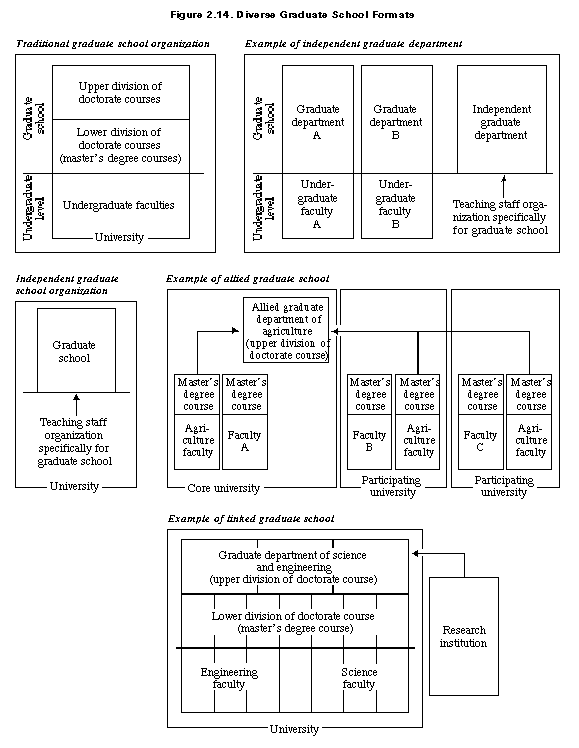
Special budgetary mechanisms are available for graduate schools, whether national, local public, or private, that are expected to produce outstanding educational or research achievements or are actively involved in new ventures. The purpose of this type of support is to place priority on encouragement of the advancement of education and research in graduate schools.
The advancement promotion special expenditure system was established in fiscal 1992 to give priority to encouragement of the advancement of education and research, especially at graduate schools, through support for educational and research activities, including joint research, research exchange, the use of teaching assistants, and international exchange. In fiscal 1995, 9,981 million yen was allocated for this purpose.
In fiscal 1987 the Government established a system for subsidizing advanced equipment for graduate schools with the aim of achieving rapid improvements in the conditions of graduate education and research. Under this system funds are made available to graduate school research programs that are generating excellent educational and research results. The funds are used to install advanced educational facilities necessitated by scientific fields and educational activities. In fiscal 1995 the Government allocated 6,343 million yen for this purpose.
Various forms of student financial support are also provided to enable outstanding graduate students to continue their studies without worrying about finances. First, the Japan Society for the Promotion of Science offers research fellowships to outstanding young researchers engaged in highly original and advanced research activities (the JSPS fellowship program for young Japanese researchers). Postdoctorate (PD) fellows receive 282,000 yen a month and doctorate course (DC) students 195,000 yen a month. Research funding of up to 1.5 million yen is also provided ( Figures 2.15 ), ( Figures 2.16 ). Second, the Japan Scholarship Foundation provides scholarship loans of 81,000 yen a month for master's degree course students and 112,000 yen a month for doctorate course students ( Table 2.3 ). Third, support is provided through the teaching assistant (TA) program. (All amounts shown are based on the fiscal 1995 budget.) The results of the January 1995 survey described later in this section indicate that there is strong demand for the expansion of scholarship loans and other forms of financial support, and it will be necessary to further improve support measures.
MESSC is implementing the 100,000 Foreign Students Plan, which aims to increase the number of students from abroad to 100,000 by the start of the twenty-first century. This goal assumes the acceptance of 30,000 students at the graduate school level. As of May 1994, 17,740 foreign students were studying at graduate schools in Japan ( Figure 2.17 ). The improvement of admission systems for foreign students at the graduate level is an important priority from the viewpoint of promoting international exchange in education as part of Japan's efforts to make an international contribution appropriate to its rising international status.
Education and research guidance for foreign students must reflect those students' needs. Some universities are actively facilitating the admission of foreign students through measures that include the expansion of Japanese language education programs, the introduction of instruction in foreign languages, and provision for theses in foreign languages. Efforts are also being made to improve education and research guidance systems in graduate departments to which large numbers of foreign students have been admitted. Measures in this area include the appointment of more teaching staff to research programs.
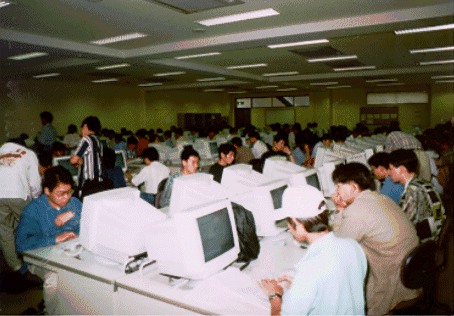
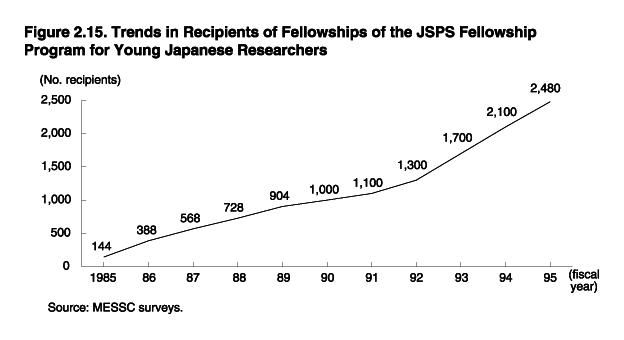
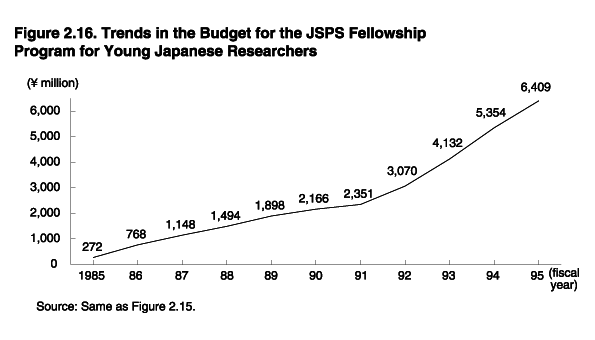
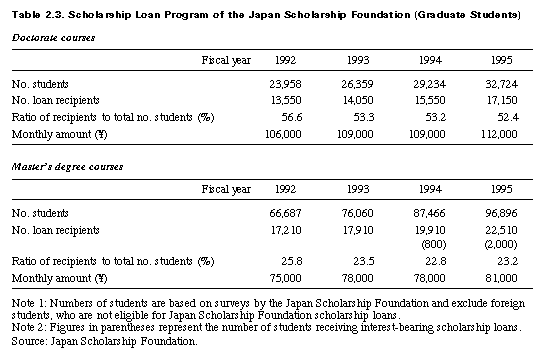
| Back to Top | MEXT HOME |